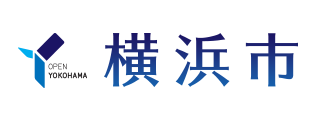- Yokohama-shi Top Page
- Disaster prevention and emergency services
- First aid
- Method of first aid, etc.
- First aid other than life-saving treatment
Here's the text.
First aid other than life-saving treatment
Last Updated September 25, 2019
Other basic skills of first aid
Video of First Aid
Planning: Noge Printing Co., Ltd., Supervised: City of Yokohama, Fire Bureau
Video of how to transport the victim
Planning: Noge Printing Co., Ltd., Supervised: City of Yokohama, Fire Bureau
How to manage the injured
How to loosen clothes
Take a comfortable posture for the victim and loosen clothes and belts. Clothes should be rested and loosened as much as possible to avoid disturbing the victim.
- If the victim is conscious, give a good explanation, loosen your clothes while listening to hope, and do not force yourself.
- If life-saving measures are needed, priority should be given.
Heat retention (keeping the patient's body temperature)
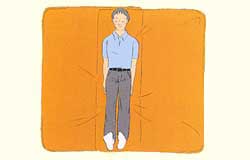
Example of heat retention
If chills, reduced body temperature, pale face, shock symptoms, etc. are seen, keep the patient warm with a blanket etc. so that the patient's body temperature does not escape.
- Warm the victim with an electric blanket, hot water dandelion, anchor, etc. must not be done except when instructed by a doctor.
- Heat retention when laying on the ground or concrete floor is thicker than hanging on the body.
- Except for heat stroke, implement it regardless of the season.
- Be careful not to give pressure by keeping it warm.
- If your clothes are wet, take them off and keep them warm.
How to manage positions
- Maintaining a suitable position (posture) for the victim is effective in maintaining breathing and circulation functions, relieving pain, and preventing symptoms from worsening.
- Take the most comfortable position desired by the victim.
- You should not force your position.
- If you change your position, do not give pain or anxiety.
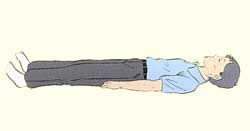
Upright position
Suppressed position (on the back)
- It is a horizontal position with the back down.
- Do not give excessive tension to the muscles of the whole body.
- It is the most stable and natural posture.
- It is a suitable posture for performing cardiopulmonary resuscitation.
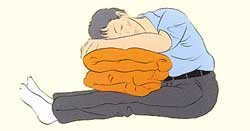
Sitting position
Sitting position
- It is a position in a sitting state.
- Suitable for victims complaining of pain in chest and breathing.
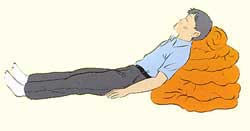
Half-seat
Half-seat
- It is a position where the upper body is lightly raised.
- Suitable for those who have difficulty breathing or breathing.
- Suitable for head injuries or cerebrovascular disorders.
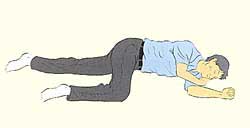
Recovery position
Recovery position (side position
- Leave the victim sideways, put the lower chin forward to secure the airway, bend both elbows, put the back of the upper hand under the face, bend the upper knee about 90 degrees, so that it does not fall back It is a position.
- It is easy to remove the vomit from the mouth.
- It is effective in preventing suffocation.
- Suitable for unconscious victims.
First aid for fractures
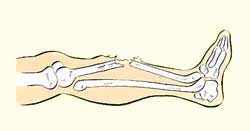
Example of fractures
1.Check the fracture area
- I ask where it hurts.
- Make sure you have a pain.
- See if there is any deformation or bleeding. (I have severe pain and swelling and cannot move. Deformation is recognized. The bones are popping out.
If you check, do not move where you are hurt. If there is a suspicion of a fracture, treat it as if it were broken.
2.Fix the broken bone. (e.g. tree, newspaper, triangular band, etc.)
- If you have a collaborators, you will be able to support your broken bone.
- If the victim can support it, he will be supported by himself.
- I'll give you a second child.
- Fix the fracture with a triangular band.
- Don't force the deformed part to its original state.
The assistant prepares a length that can fix the upper and lower joints of the fracture. When fixing, inform the victim before fixing.
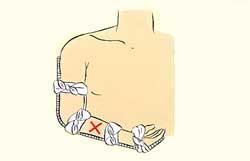
Fixing the arm
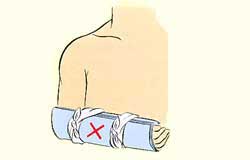
Fixing the forearm part using a magazine
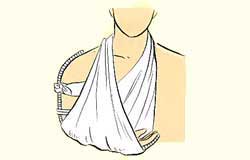
Hold your arms with a triangular band
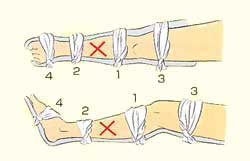 Fixing feet
Fixing feet
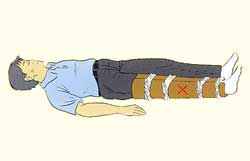 Fixing feet using cardboard, etc.
Fixing feet using cardboard, etc.
First Aid for Injuries
1.Bandage method
- Bandages are performed to protect kizus and prevent bacteria from entering.
- Use as clean bandages as much as possible.
- Use a size that can fully cover the kizu.
- If there is bleeding, use a sufficiently thick gauze, etc.
- If the mouth is open, use sterilized gauze in principle and do not use cotton or filthy items.
- When dealing with sterile gauze, treat it cleanly.
- If the crouch is dirty with earth and sand, wash it off with clean water and treat it cleanly.
- Please pay attention to the expiration date of the sterilized material.
Wrap the bandage with caution, as it may cause blood circulation disorders when wrapped strongly. The knot of the bandage should be avoided over the mouth.
2.Triangular width
- It can be used for any part of the body.
- It can be used regardless of the size of the kizu.
- Apply gauze etc. to the kizuguchi and then use a triangle band.
Transport method
The transport of the victim is performed after first aid has been given or to move from a dangerous place to a safe place. It is important to transport safely without causing distress to the victim.
Stretcher transport method
1.Stretcher transport method
Stretcher transport is carried out after giving first aid to the victim, kept warm, and in principle, transported forward to the foot side. During transport, it is necessary to reduce agitation and vibration.
2.First-aid stretcher preparation method
- Stretcher with bamboo and blankets: Place one bamboo zao in one-third of the blanket and fold one blanket. Place the second bamboo zao according to the patient's shoulder width, fold the upper blanket (at least 15 cm before turning) and fold the lower blanket.
- Application stretcher using clothes: Prepare 5 or more jackets, and place the buttons on the jacket and pass them through the bamboo groove from both sides.
Method of transporting by one person
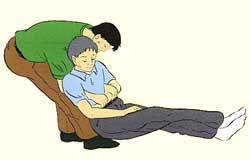
How to move from the back to the back
- Move the back from the back to the back, with the buttocks lifted up.
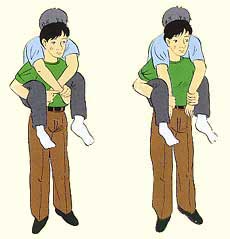
How to carry it on your back
- Carry and transport the victim's arms cross or parallel, and carry them with both hands.
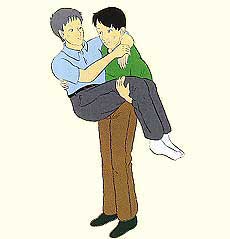
How to transport with a horizontal holding
- It is easier for children, baby/infant and small people to carry by holding them horizontally.
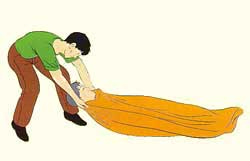
Transport method using blankets
- Be aware that blankets and sheets are often used to compress the victim's chest and abdomen.
Carry in the most appropriate manner depending on the condition of the victim, the location of the injury, and the type of disease. Only when it is unavoidable, try to transport by multiple people.
How to transport by two people
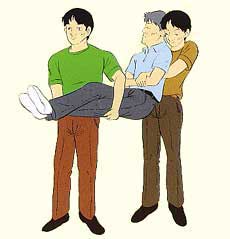
A method of transporting the victim back and forth
- A method of transporting the front and back of the victim
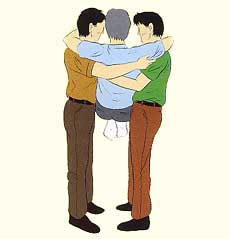
How to transport with both hands crossed
- How to transport with both hands crossed
Be careful to secure the airway, as the victim's neck may fall forward. Two people will keep pace with each other so that they will not be upset when transporting.
How to transport by 3 people
- Notes on transporting by 3 people
- Hold the knees on the foot side and fold the knees on the head side.
- Put your arms well under the victim.
- 3 people act at the same time.
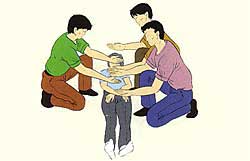 Method of transporting by 3 people 1
Method of transporting by 3 people 1
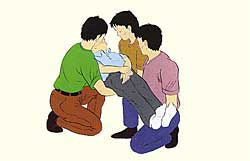 Method of transporting by 3 persons 2
Method of transporting by 3 persons 2
First Aid for neck injuries
1.Ask if you have any of the following symptoms
- Do you have a pain in your neck?
- Isn't breathing difficult?
- Can you move your limbs or numbness?
If there is at least one of these symptoms, it is judged that the neck bone is hurt.
2.Don't move your neck.
- If you have consciousness, tell them not to move.
- Hold your head with both hands so that it does not move.
- Call out and cheer up.
If the surrounding situation of the victim is safe, keep it as it is.
3.If it is unavoidable to move
- Gather cooperators.
- Place it on a hard flat, such as a board, and fix it so that the whole body does not move.
- Move to rest.
Do not move unless there is a surrounding situation that could endanger the life of the victim.
First aid for drowning
1.Rescue a drowning person
- If you find a drowning person, first call 119 and notify the people around you.
- If there is a rescue floating ring that can be caught around and floated, throw it to a drowning person. If there is a rope, throw it over and draw it to the land.
In some cases, rescue is left to specialists such as firefighters and life savers, as there are cases where they are caught and drowned in an attempt to rescue themselves. If a drowning person is submerged, remember the submerged place with a mark and tell the firefighters and other experts who arrived.
2.Conducting cardiopulmonary resuscitation (securing airways, artificial respiration, heart massage)
- If you are unconscious, secure the airway. If breathing is not seen in that condition, it is important to start cardiopulmonary resuscitation immediately.
In the event of a dive accident, pay special attention to the neck injury. If neck injury is suspected, secure the airway by lower jawlifting method. In the event of a drowning accident, it is important to start artificial respiration as soon as possible (even during rescue from underwater if possible). Also, do not spend time spiting water.
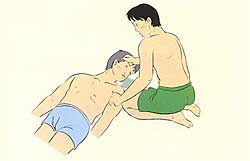
If a drowning person vomits
3.If a drowning person vomits
- If a drowning person vomits, immediately turn his face to the side. If it is determined that there is an injury to the neck, turn the body sideways and support the head so that it does not fall.
- After that, clean the mouth and continue cardiopulmonary resuscitation again.
- You don't have to force your abdomen to spit water.
First aid for burns (burns)
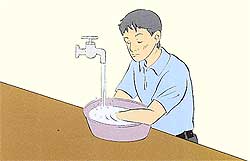
Cooling burns
- Cool as soon as possible with clean cold water until the pain is eased.
If you are wearing clothes such as socks, cool the clothes. Be careful not to break the blisters. In the case of a wide range of burns, be careful not to get too cold when cooling. Be careful as long-term cooling with ice or ice water can be too cold and worse.
Response to shock conditions
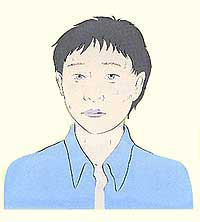
The face of a shocked person
1.View of Shocks
- Look at your complexion.
- See breathing.
The symptoms of shock are as follows.
- My eyes turn down.
- Breathing is fast and shallow.
- I have a cold sweat.
- The expression is vague (greedless).
- The lips are purple or whitish (cyanosis).
- The body trembles.
- The skin is pale and cold.
2.First Aid for Shock
- Lay the victim horizontally.
- Raise your legs by about 15cm to 30cm high.
- Loosen your tie or belt.
- Put a blanket or clothes to keep it warm.
- Call out and cheer up.
If you have shock symptoms, you may be at risk. Please call 119 immediately.
Removal of foreign substances (treatment when foreign substances such as food are clogged in the mouth, etc.)
A method of removing foreign substances when foreign substances (food, vomit, blood, etc.) are clogged in the mouth or throat (airway obstruction) are strongly suspected.
How to remove foreign substances when the victim responds (consciousness)
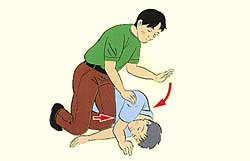
Back tapping method
1.Back tapping method
- Relax your knees and turn the victim toward you in a lateral lying position.
- In the palm of the hand (the part close to the base of the hand), hit the scapula several times strongly and continuously.
- In addition to the lateral position, there is also a method of sitting position or standing position.
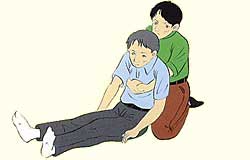
Abdominal protrusion method
2.Abdominal protrusion method
- Turn your arms from behind.
- Make a fist with one hand and hit it slightly below the victim's groove.
- Hold it with the other hand and push it up quickly to the foreground.
Do not go to unconscious, pregnant women, or baby/infant under one year old.
If the victim is able to cough, continue coughing as much as possible (coughing is the most effective in removing foreign substances).
When the victim does not respond (consciousness)
Even if you are conscious, if you lose consciousness during first aid, use the method when you are not conscious.
- If you have not called for help or call 119, do so immediately and arrange an AED.
- Start cardiopulmonary resuscitation.
- If a foreign object is visible in the mouth during cardiopulmonary resuscitation, remove the foreign object.
- If a foreign object is not visible in the mouth, do cardiopulmonary resuscitation without spending time searching for the foreign object.
baby/infant, Removal of Newborns
- The method of removing foreign bodies for children (1 year or older) is the same as for adults.
- Methods for suspected airway obstruction due to foreign substances in baby/infant and newborn babies under one year of age.
When conscious (responding to stimulation)
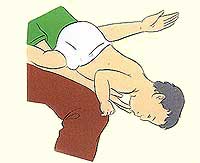
Drawing on the back of the baby/infant
1.I hit my back with the back tapping method.
- Make your stomach hungry on one arm and make your head low.
- After putting your chin on your hand, try to push it out.
- Strongly hit the middle of the back at the base of the other hand.
For baby/infant and newborns, abdomen should not be used.
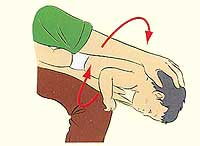
Return it upwards
2.Then, if there is no response, cardiopulmonary resuscitation against baby/infant is performed.
- Support baby/infant's head and back, scissors with both forearms and turn upside down.
- With his overturned baby/infant on the other forearm and keeping his head low, he performs chest compressions with two fingers, 30 times at a tempo of 100 to 120 times a minute, and mouth-to-mouth respiration twice in one second.
If you are unconscious
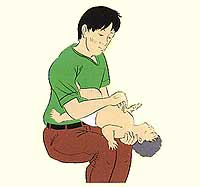
CPR of baby/infant
- Call for help immediately, call 119, and start cardiopulmonary resuscitation. If no one calls for help (if there is only one rescuer), first call 119 yourself, make an arrangement if the AED is nearby, and perform regular cardiopulmonary resuscitation.
- Perform artificial respiration with the airway secured. When performing artificial respiration, remove the foreign object if the foreign object is visible in the mouth.
- If foreign matter is not visible in the mouth, continue cardiopulmonary resuscitation with the airway secured.
Inquiries to this page
Emergency Guidance Division, Fire Bureau Emergency Department
Telephone: 045-334-6797
Telephone: 045-334-6797
Fax: 045-334-6710
Email address: sy-kyukyushido@city.yokohama.lg.jp
Page ID: 681-042-863

